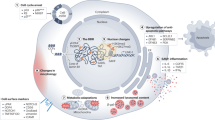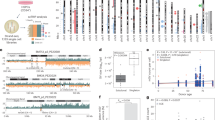Abstract
IN the course of studying 140 human tumours in tissue culture, a rapidly proliferating strain of cells was obtained from epidermoid carcinomatous tissue, part of which came directly from the patient (H.) (Jan. 21, 1953) and part from an animal (rat) implantation (Sept. 5, 1952) of cells from the tumour, a slowly growing epidermoid carcinoma of the larynx. The cultures have maintained for two years a consistent growth-pattern closely resembling morphologically the malignant tissue from the patient. The strain, being the first permanent one developed in the series, has been designated the A strain. During the first few months of propagation, conditioned medium was employed from cultures made from patients K. and F., having epidermoid carcinomas of the neck and cervix respectively. Because of the possibility of the presence of rat cells in the strain, a study (carried out by Dr. J. J. Biesele, Sloan-Kettering Institute, New York) of the chromosomes was undertaken, after a year in tissue culture, which indicated that the cells were of human origin, having characteristic V- and J-shaped chromosomes.
This is a preview of subscription content, access via your institution
Access options
Similar content being viewed by others
References
Hadfield, G., Brit. Med. J., ii, 607 (Sept. 11, 1954). See also ibid., 635.
Author information
Authors and Affiliations
Rights and permissions
About this article
Cite this article
FJELDE, A. Observations on a Human Tumour in Tissue Culture. Nature 175, 434–435 (1955). https://doi.org/10.1038/175434b0
Issue Date:
DOI: https://doi.org/10.1038/175434b0
This article is cited by
-
Entwicklung und Verhalten eines Rattensarkoms während 5jähriger Züchtung in der Gewebekultur
Zeitschrift für Krebsforschung (1960)
-
Mitoseablaufst�rungen
Zeitschrift f�r Zellforschung und Mikroskopische Anatomie (1960)
-
�ber adaptive Ver�nderungen der morphologischen Eigenschaften eines Mammacarcinoms der Maus
Zeitschrift f�r Krebsforschung (1959)
-
Cytologische und enzymcytochemische Untersuchungen �ber die Zelloberfl�che an in vitro gez�chteten Zellen
Zeitschrift f�r Zellforschung und Mikroskopische Anatomie (1959)
-
Vergleichende enzymhistochemische Beobachtungen zum Phosphatasenachweis an einigen Carcinomzellst�mmen in vitro sowie �ber milieubedingte Ver�nderungen der Enzymaktivit�t
Zeitschrift f�r Krebsforschung (1959)
Comments
By submitting a comment you agree to abide by our Terms and Community Guidelines. If you find something abusive or that does not comply with our terms or guidelines please flag it as inappropriate.



